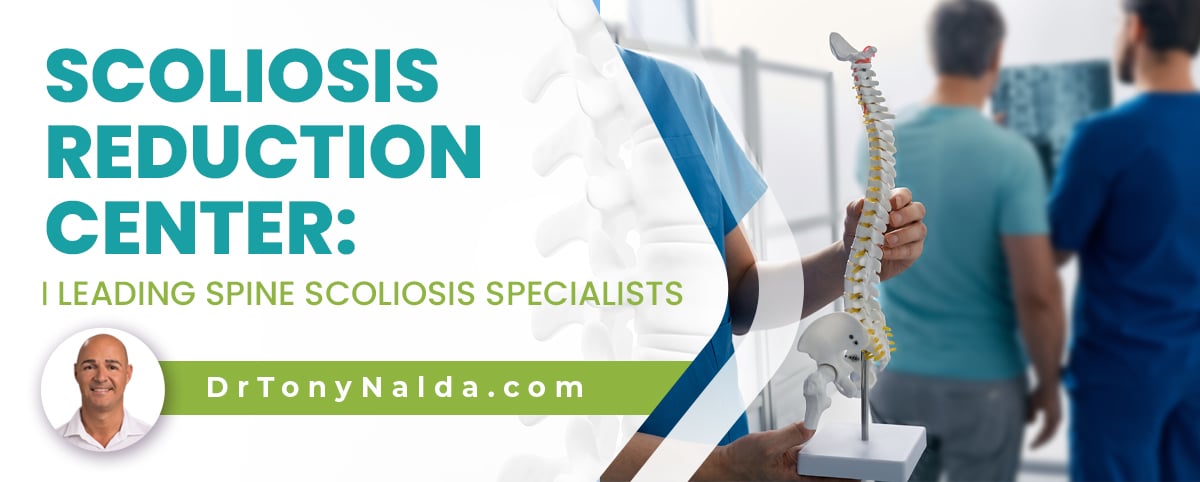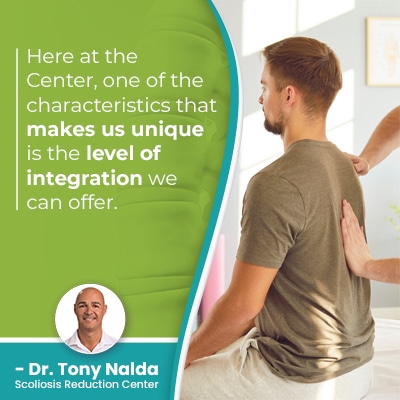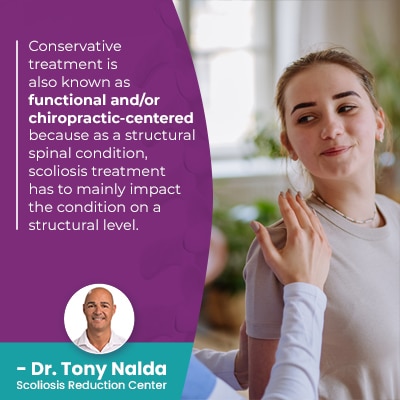Scoliosis Reduction Center: Leading Spine Scoliosis Specialists

As a leading scoliosis specialist, Dr.Tony Nalda is trained and certified in a number of scoliosis-specific treatment disciplines, and this is why patients of the Center can experience treatment plans that are 100-percent customized.
What makes the Scoliosis Reduction Center® unique? The Center's innovative approach has been providing a powerful non-surgical treatment alternative for 25+ years. The Center uses state of the art technology, provides access to multiple forms of treatment under one roof, and produces impressive results.
When it comes to non-surgical scoliosis treatment, being proactive is key because sometimes when treatment is started can be as important as the treatment itself.
Table of Contents
Scoliosis is Progressive
Scoliosis is a progressive structural spinal condition whose nature is to get worse over time, meaning the unnatural sideways-bending and rotating spinal curve will increase in size.
We don't always know what causes scoliosis to develop initially, but we know it's growth that causes it to progress, which is why childhood scoliosis should always be taken seriously.
As growth triggers progression, the more growth a young patient has yet to go through before reaching skeletal maturity, the more potential progression they could face.
Scoliosis progression makes it more complex to treat; smaller curves are easier to correct.
In addition, as scoliosis progresses, its effects become more pronounced, and in children, this involves postural changes, and in adults, the main scoliosis symptom is pain.
In children, often the condition's earliest signs are uneven shoulders and hips, and as scoliosis progresses, the body's center of gravity shifts, causing additional disruptions to balance, coordination, and gait.
Disruptions to Posture and Movement
Disruptions to posture will become more overt the more scoliosis progresses, and in addition to uneven shoulders and hips, postural changes associated with scoliosis can also include:
- The head appearing not centered over the torso
- An uneven eye line
- uneven shoulder blades
- The development of a rib cage arch
- Arms and legs that appear to hang at different lengths
Postural and movement changes are a result of the condition's uneven forces disrupting the body's overall symmetry.
Scoliosis is also associated with a muscular imbalance, and this can also disrupt movement and balance.
It's not just the job of the spine to maintain its natural curves and alignment; it's also the role of the spine's surrounding muscles to provide the spine with support and stability,
An unnatural spinal curve can pull the spine's surrounding muscles in different directions with the muscles on one side becoming stretched and sore from overuse, while muscles on the other side can become weak from overuse.
In typical idiopathic scoliosis cases, curves bend to the right away from the heart, and with right-bending curves, the muscles on the right side of the spine will be overused as they try to counteract the spine's unnatural bend and twist, and the muscles on the left side can become weak from lack of use.
In fact, a focus of non surgical treatment options is on improving the spine's surrounding muscle strength and balance.
Spinal Rigidity
 As scoliosis progresses, the spine is becoming increasingly rigid, making it less responsive to treatment and disrupting the spine's flexibility and range of motion.
As scoliosis progresses, the spine is becoming increasingly rigid, making it less responsive to treatment and disrupting the spine's flexibility and range of motion.
Increasing spinal rigidity is another reason a proactive treatment approach is favorable; preventing progression can mean preserving spinal strength and function so the spine can be responsive to chiropractic care, physical therapy, and corrective bracing.
Here at the Center, being proactive with treatment means starting it as close to the time of diagnosis as possible, when conditions are at their mildest and spines are at their most flexible.
For my patients who have already experienced a lot of progression by the time they are diagnosed, there is still hope; preparatory work that has the goal of establishing a baseline level of spinal flexibility can be necessary to ready the spine and its surroundings for treatment.
When the spine is still flexible, treatment can be started immediately, and when it comes to proactive non-surgical treatment, this is where the Scoliosis Reduction Center®has made its mark.
Conservative Treatment Disciplines
Here at the Center, one of the characteristics that makes us unique is the level of integration we can offer.
Being trained and certified in CLEAR Scoliosis Institute protocols, SEAS (Scientific Exercise Approach to Scoliosis), the Schroth Method, ISICO's World Masters Certification, Chiropractic Biophysics, Gomez Orthotics, and DMX (digital motion X-ray) allows me to comprehensively craft treatment plans.
Patients of the Center benefit from having access to multiple powerful and scoliosis-specific treatment disciplines under one roof.
I can fully individualize treatment because I can apply a number of different types of treatment, and adjust them accordingly throughout based on how the spine is responding to treatment and/or growth (childhood scoliosis).
Conservative treatment is also known as functional and/or chiropractic-centered because as a structural spinal condition, scoliosis treatment has to mainly impact the condition on a structural level.
Chiropractic Care and Curvature Reductions
Chiropractic care can involve a number of techniques and manual adjustments that can work towards realigning the spine by adjusting the position of the curve's most-tilted vertebrae, and when successful, this can help restore as much of the spine's healthy curves as possible.
The spine's healthy curves make it stronger, more flexible, and better able to handle mechanical stress, so reducing a scoliotic curve means restoring as much of the spine's healthy curves as possible.
Improving a single unhealthy curve means improving the entire spine's biomechanics because the health of each spinal section is dependent on the health of the others.
While scoliosis is a structural condition, it's not just up to the spine to maintain its natural curves and alignment, but also the role of the spine's surrounding muscles to provide it with support and stability.
Physical Therapy and Scoliosis Exercises
When it comes to improving the strength and balance of the spine's surrounding muscles, physical therapy and scoliosis-specific exercises are a key focus of the Center's non surgical treatment options.
Physical therapy can work towards strengthening the weak muscles and relaxing the overused muscles that surround the spine, and this means better stability for the spine and can help maintain an economical gait.
Scoliosis exercises and physical therapy can also help improve posture and activate specific areas of the brain for improved brain-body communication and body positioning.
Corrective Bracing
 Modern bracing is corrective, customized, and addresses the condition's true 3-dimensional nature.
Modern bracing is corrective, customized, and addresses the condition's true 3-dimensional nature.
As growing spines are more malleable, bracing is a common facet of childhood scoliosis treatment and can help by pushing the spine into a corrective position, so young patients can benefit from proactive treatment that includes corrective bracing.
The ScoliBrace is the Center's brace of choice for many patients with an unnatural curvature of the spine.
Rehabilitation
As a progressive condition, scoliosis is incurable, but it can be highly treatable, particularly with early detection and intervention.
What patients need to understand is that there is no curing scoliosis; treatment is more about how best to manage an ongoing condition.
There are a number of professional athletes and celebrities who didn't let their scoliosis slow them down, and rehabilitation is about holding treatment results for the long term, and that can include curvature reductions, improvements to posture, and pain management.
Rehabilitation can involve lifestyle guidance, continued chiropractic care, and the prescription of a series of scoliosis-specific exercises designed to further heal and stabilize the spine; exercises can be performed from home.
Conclusion
Orlando, Florida's Scoliosis Reduction Center® has a lot to offer its patients; from its uniquely innovative and integrative approach to the complete customization of treatment plans, Dr. Tony's been treating scoliosis without surgery for 25+ years.
The Center's results speak for themselves, proving that watchful waiting and scoliosis left untreated can become severe cases, and that many patients with scoliosis don't need scoliosis surgery.
A comprehensive treatment plan designed by chiropractic spine specialists can offer treatment results that include preserving as much of the spine's natural strength and function as possible, whereas an abnormal curvature of the spine treated by spine surgeons is likely to be weaker, more vulnerable to injury, and less functional.
With the Scoliosis Research Society estimating close to seven million Americans are currently living with scoliosis, a spine center offering proactive treatment has become a welcome necessity.
Orthopedic surgeons have their patients' best interests at heart, but conservative treatment options are minimally invasive and provide a more-natural alternative to complex spine surgery.
A spinal deformity like scoliosis is one that should always be taken seriously, and as the condition can range from mild scoliosis to moderate, severe and very severe cases, symptoms can also vary widely.
Conservative treatments can help improve muscle weakness, imbalance, compression of the nerves, nerve pain, back pain, tingling sensations, posture, hip alignment, neck pain, and more.
So if you or someone you care about is in need of assessment or treatment, don't hesitate to reach out for a consultation.
Dr. Tony Nalda
DOCTOR OF CHIROPRACTIC
After receiving an undergraduate degree in psychology and his Doctorate of Chiropractic from Life University, Dr. Nalda settled in Celebration, Florida and proceeded to build one of Central Florida’s most successful chiropractic clinics.
His experience with patients suffering from scoliosis, and the confusion and frustration they faced, led him to seek a specialty in scoliosis care. In 2006 he completed his Intensive Care Certification from CLEAR Institute, a leading scoliosis educational and certification center.
About Dr. Tony Nalda
 Ready to explore scoliosis treatment? Contact Us Now
Ready to explore scoliosis treatment? Contact Us Now





